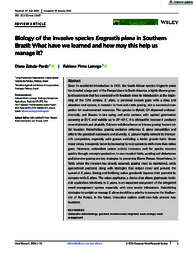Biology of the invasive species Eragrostis plana in Southern Brazil: what have we learned and how may this help us manage it?
Biology of the invasive species Eragrostis plana in Southern Brazil: what have we learned and how may this help us manage it?
Author(s): ZABALA-PARDO, D.; LAMEGO, F. P.
Summary: Abstract: Since its accidental introduction in 1951, the South African species Eragrostis plana has invaded a large part of the Pampa biome in South America, a highly diverse grassland ecosystem that has coexisted with livestock since its introduction at the beginning of the 17th century. E. plana, a perennial tussock grass with a deep and abundant root system, is resistant to frost and cattle grazing, and a successful competitor for environmental resources. The species is diploid, C4 dispersed endozoochorically, and flowers in late spring and early summer, with optimal germination occurring at 35°C and viability up to 39–40°C. It is allelopathic because it produces several phenols and alkaloids. Extreme soil disturbance or intense grazing favours initial invasion. Nonetheless, grazing exclusion enhances E. plana competition and affects the grassland community and diversity. E. plana is highly tolerant to interspecific competition, especially with grasses exhibiting a similar growth habit. Under water stress, it responds faster by increasing its root system by 66% more than native grass. Moreover, antioxidant system activity increases, and the species recovers quickly through osmolyte production. In non-invaded fields, avoiding soil disturbance and intensive grazing are key strategies to preserving Biome Pampa. Nonetheless, in fields where the invasion has already occurred, grazing must be maintained, cattle quarantined practiced, along with strategies that reduce cover and prevent the spread of E. plana. Liming and fertilising native grasslands improve their potential to compete with E. plana. The wiper applicator, a device that allows glyphosate herbicide application selectively to E. plana, is an important component of the integrated weed management system, especially with very severe infestations. Establishing strategies to contain or manage E. plana should be a priority to preserve the biodiversity of the Pampa. In the future, innovative options could also help prevent new invasions.
Publication year: 2024
Types of publication: Journal article
Observation
Some of Embrapa's publications are published as ePub files. To read them, use or download one of the following free software options to your computer or mobile device. Android: Google Play Books; IOS: iBooks; Windows and Linux: Calibre.
Access other publications
Access the Agricultural Research Database (BDPA) to consult Embrapa's full library collection and records.
Visit Embrapa Bookstore to purchase books and other publications sold by Embrapa.

